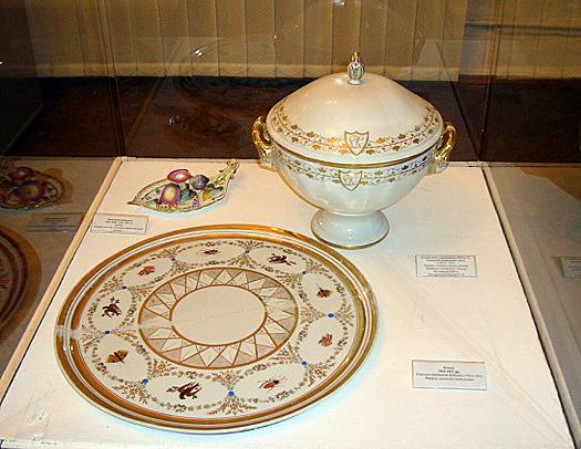Mezhyhiria Faience Factory
Mezhyhiria Faience Factory (Межигірська фаянсова фабрика; Mezhyhirska faiansova fabryka). One of the first factories in Ukraine. It was established in 1798 on land belonging to the Mezhyhiria Transfiguration Monastery, near a large deposit of high-quality faience clay. It was owned and administered by the Kyiv magistrat until 1810, when it burned down. It was rebuilt by the Russian government and from 1822 was overseen by the imperial cabinet.
Initially the factory employed foreign artisans and craftsmen. Later on Ukrainians were trained, and in 1826 a school was established there to train artists and craftsmen. Most of the Ukrainian workers were state peasants from the villages of Novi Petrivtsi and Valky, in Kyiv gubernia. The factory produced plates and dishes, church vessels, decorative vases and plates, porcelain Easter eggs and sculptures, and other objects. The early products followed Western classicist styles, but the factory soon developed a unique, Ukrainian style of porcelain design and decoration based on folk motifs. In the second half of the 19th century it also produced plates decorated with portraits of Ukrainian national figures, such as Taras Shevchenko, Panteleimon Kulish, and Mykola Kostomarov; scenes of everyday Ukrainian life; landscapes; and historic buildings and monuments. Articles produced by the Mezhyhiria factory were popular throughout Ukraine, Belarus, and Russia. Some were exported and can be found in museums in Western Europe. In the 1850s the factory started to decline, and in 1874 it was closed.
BIBLIOGRAPHY
Kuz'min, E. ‘Mezhigorskii faians,’ Iskusstvo, 1911, nos 6–7
Ohloblyn, O. ‘Arkhiv Kyïvo-Mezhyhirs'koï faiansovoï fabryky,’ Zapysky Istorychno filohichnoho viddilu VUAN, 9 (1926)
Dolyns’kyi, L. Ukraïns’kyi khudozhnii farfor (Kyiv 1963)
Oleksander Ohloblyn
[This article originally appeared in the Encyclopedia of Ukraine, vol. 3 (1993).]

